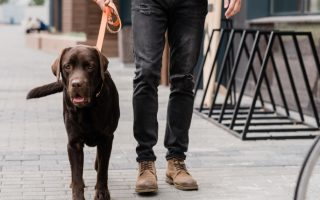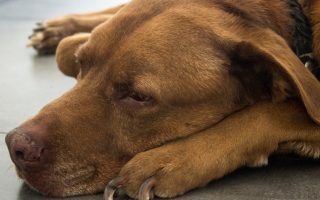Getting yourself ready for a new tiny family member is a full-time job. There are parenting books to read, accessories to buy and assemble, gynecologist appointments, and the list goes on!. Here’s what your Dos and Don’ts are for Introducing Your Labrador to Your Newborn Baby.
Then there is your Labrador, who is absolutely unaware that his life is about to change. It’s not like Labrador don’t love Newborn Baby; it’s just that the Instagram-ready scenario is perhaps not as common as you think. Nonetheless, there are some tips you can follow to set your lab and your human baby up for a forever friendship.
Here we have listed some simple yet smart things you can do to ensure your canine and baby will grow up to be best buddies.

Do’s of introducing your Labrador to your newborn baby.
Train your lab well
Take advantage of the time you have before your baby’s arrival and brush up on some basic dog commands. Make stepwise adjustments to your place and schedule and adjust your pet accordingly.
Once your little-you arrives, you will be pretty occupied. So it would be beneficial if your lab could understand some basic commands without you having to get involved. Some useful commands for a safe Labrador Newborn Baby interaction include:
- Sit
- Go to __( command to go to a particular spot)
- Stay
- On/off
- Away ( come on to make a dog move away from you, baby, or something else)
- Leave it
- Lay down
- Drop it
- Up and down (command to teach your canine to go up and down the stairs without hesitation. Use the stay command to prevent your dog from knocking you over when you are carrying the baby)
Practice these cues in different situations to make sure your dog understands you. If your pooch isn’t crate-trained, this may be the perfect time to start. A crate can be a fine place for your Labrador puppy to feel safe if things get crazy.
Introduce your baby’s scent
After the new family addition is born, ask your partner to bring something home from the hospital carrying your kid’s scent and let the pup investigate it. It could be a receiving blanket, a simple washcloth, or anything. It will help your dog familiarize himself with the baby’s scent before the actual interaction.
Make adjustments before the baby’s arrival.
The new addition will bring a significant shift in your pup’s life; it’s better to make some changes in advance. Labradors are highly sensitive, and it’s natural for them to get curious or anxious about all this Labrador Newborn Baby stuff. So it’s wise to be safe than sorry. Assist your lab in the adjustments to mitigate any negative associations the pup might make about the switches and the baby.
For instance, if your pooch snuggles and naps in your bed, it’s better to shift him to a new place before the baby is home. Also, if you could anticipate any other changes, make those in advance too.
Provide the dog with a baby-free zone
Not all, but some fur babies get overwhelmed with the activities associated with kids, like coddling and caring. Some may even feel irritated by your baby’s noises and sudden cries.
Just like humans, canines need to get away from all the commotion. Make sure your fido has its own place to escape. This might mean shifting the puppy mat to a cozier and quiet space in the house or lying his favorite blanket in front of the window so he can chill out.
Teach your baby to respect your lab
When babies start crawling and are old enough to grab things with their tiny hands, they get highly interested in your lovely Labrador. This could be the formation of a beautiful bond, but for it to develop, you need to make sure your kids don’t annoy the furball.
Preparing your kids how to respect a dog is a vital part of a loving and loyal companionship that grows over time. This means teaching your kids how to interact with a dog appropriately, not to pull the tail and ears or grab the fido by his hair. Remember, it’s never too soon to teach your little one empathy and how to respect someone’s personal space.
Catch your dog’s cues
Keep a careful eye on your dog, especially after bringing the kid home and after he starts crawling. If your dog feels uncomfortable, growls, or moves away, he is signaling you something. No, it does not mean he wishes to harm the baby; it just means he is anxious. Pay close attention to the cues your dog provides around kids to create a baby-safe environment.

Make your dog a part of the baby’s activities.
Involve your Labrador in the things you do with your little one. Talk to them both and make your dog feel included. If your dog doesn’t show any symptoms of uneasiness, let him be around when you are playing with your baby, nursing, or changing diaper and clothes.
Another excellent way for both of your babies to bond is to go for a walk together. But whatever you do, make sure you are calm and in complete control of the situation.
Observe any changes in your Labrador’s temperament
It’s more than typical for dogs to get depressed. Observe any changes in your canine’s demeanor, especially if he stops being cheerful and happy. Depression in puppies is not much different from depression in humans and can crop up after significant changes like moving or a new addition to the environment. But there are some things you can do to help, and the best one is to consult a veterinarian or a professional Labrador behaviorist.
Keep loving your dog as you always did
That lovely Labrador was your original baby. Your heart made room for your new baby, but there is still a special place left for your precious doggo. Initially, it might feel overwhelming to care for everyone, so ask for assistance from your peers and partner. Once your kid is old enough to respect your dog, you will notice a tremendous, carefree relationship. Labradors are just the match for kids, which is another reason to love them even more!
Don’ts for introducing your Labrador to your newborn baby
Don’t assume any sudden miracles.
Your pup may take a while to understand that the baby is a permanent part of the family and isn’t going anywhere soon. It could be a time of adjustment for the fido as he learns to figure out his place in the new family hierarchy. Your lab may become extra needy and seek your attention even more after the baby arrives. Though the situation will be tough on you, don’t lose your temper as it could scare the canine. Keep your partner on board to support and manage the little pup.
Don’t force the introduction.
As tempting as it may seem, there is no need to rush the introduction between your dog and the baby the minute you come home from the hospital. Take your time and keep both of them separated for a few days. Let the dog observe the baby’s smell from a safe distance and understand the dynamics. Don’t force any interaction, and try your best to maintain the respect of space before the first hello.
Don’t leave them unsupervised.
Labradors are known for their take-it-all-in-stride demeanor. They are typically great around kids, but you have no idea how your lab will react to the new family member for the first time. Your canines could unintentionally harm the baby even if they don’t mean to. Their curiosity and strength can cause a situation you probably don’t want to deal with. So unless you are using some protective measures like pet gates, it’s better not to leave your babies alone, even for an instant.
Don’t let anyone steal the toys.
The similarity between dog and baby toys can feel astonishing at times. But it’s best to keep them separate to prevent germs and jealousy. Some fur babies can be really possessive of their possessions, and you don’t want your canine to leash out at your little wriggler.

Don’t forget the walkies.
Being a new parent, you will have a million things to worry about, but your furball still needs his daily walkies to stay active and cheerful. Walks are your dog’s favorite part of the day and are equally important to his mental and physical wellbeing. It might not be easy to manage, but try to maintain a walking routine to get rid of the pent-up energy. If possible, take your baby out with you.
In case walks are tough for you to accommodate, consider a professional dog walking service until your routine settles down.
Don’t let your toddler play with the dog food.
One clean, freshly filled-up bowl of water and one bowl full of kibble, how fascinating for a toddler learning to grab everything!
Dog food and water bowls may look really attractive to your baby but are, in fact, very germy. Plus, it’s disrespectful to your fur baby to let your toddler get his hands in his food and water. Moreover, some food-motivated pups can be possessive and show aggression. So it’s best to avoid this situation and keep the baby away from your pet’s belongings.
Say no to doggy-back rides.
The internet is filled with videos and images of babies riding on the backs of canines. This isn’t something you should be doing. First, it is perilous for both of them. Not only there is a risk of falling for the kid, but it is unsafe for your pup’s hips and back.
Remember, canines are not ponies, and they shouldn’t be treated like one.
Bear in mind every situation is different
Maybe some peers and mates have assured you that your pooch will be fine with the new addition and the two will be nothing but the best of friends. We hope this to be true, but it isn’t smart to assume a dreamy outcome of every situation. Of course, we can expect the best, but just because a situation went a certain way for one of your friends does not mean it will do the same for you. Your Labrador and your human baby are both unique, and that’s probably one of the many reasons you adore them so much.
Help your dog work through it.
It isn’t unexpected for some canines to find kids scary, especially when they start crawling. Some pups may not have much experience with kids, leading to a fearful response. If your pooch seems excessively nervous, contemplate hiring a professional dog trainer to help you work through it.

Final words
Adequately socialized Labrador puppies want nothing but to befriend everyone. They are fascinated with everything that smells interesting, makes noise, and moves, and our kids tick all those boxes. However, to establish a lifelong companionship, you need to make preparations so everyone can live his life in perfect harmony.






